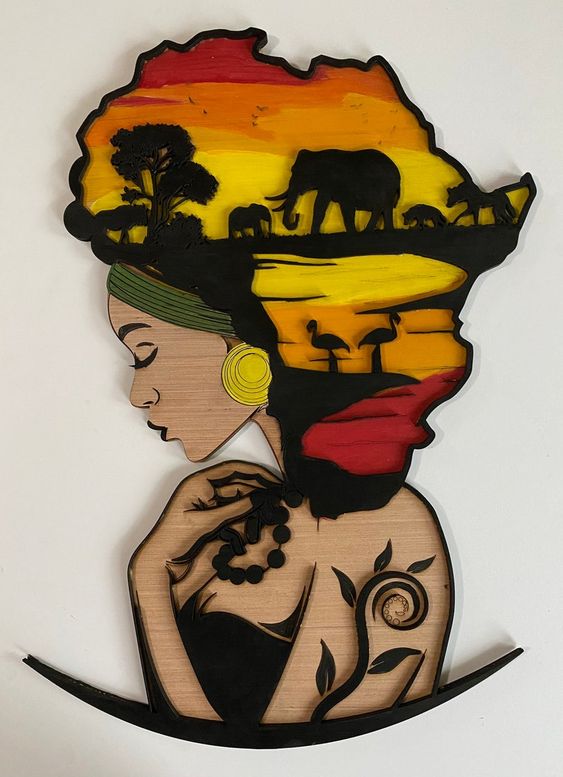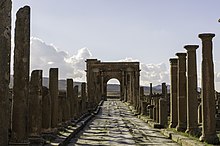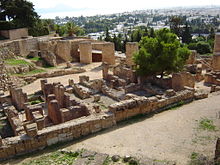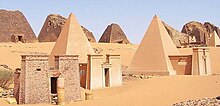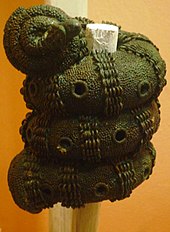Africa is the world’s second-largest and second-most populous continent, after Asia in both aspects. At about 30.3 million km2 (11.7 million square miles) including adjacent islands, it covers 20% of Earth‘s land area and 6% of its total surface area.[7] With 1.4 billion people[1][2] as of 2021, it accounts for about 18% of the world’s human population. Africa’s population is the youngest amongst all the continents;[8][9] the median age in 2012 was 19.7, when the worldwide median age was 30.4.[10] Despite a wide range of natural resources, Africa is the least wealthy continent per capita and second-least wealthy by total wealth, ahead of Oceania. Scholars have attributed this to different factors including geography, climate, tribalism,[11] colonialism, the Cold War,[12][13] neocolonialism, lack of democracy, and corruption.[11] Despite this low concentration of wealth, recent economic expansion and the large and young population make Africa an important economic market in the broader global context.
The continent is surrounded by the Mediterranean Sea to the north, the Isthmus of Suez and the Red Sea to the northeast, the Indian Ocean to the southeast and the Atlantic Ocean to the west. The continent includes Madagascar and various archipelagos. It contains 54 fully recognised sovereign states, eight cities and islands that are part of non-African states, and two de facto independent states with limited or no recognition. This count does not include Malta and Sicily, which are geologically part of the African continent. Algeria is Africa’s largest country by area, and Nigeria is its largest by population. African nations cooperate through the establishment of the African Union, which is headquartered in Addis Ababa.
Africa straddles the equator and the prime meridian. It is the only continent to stretch from the northern temperate to the southern temperate zones.[14] The majority of the continent and its countries are in the Northern Hemisphere, with a substantial portion and a number of countries in the Southern Hemisphere. Most of the continent lies in the tropics, except for a large part of Western Sahara, Algeria, Libya and Egypt, the northern tip of Mauritania, and the entire territories of Morocco, Ceuta, Melilla, and Tunisia which in turn are located above the tropic of Cancer, in the northern temperate zone. In the other extreme of the continent, southern Namibia, southern Botswana, great parts of South Africa, the entire territories of Lesotho and Eswatini and the southern tips of Mozambique and Madagascar are located below the tropic of Capricorn, in the southern temperate zone.
Africa is highly biodiverse;[15] it is the continent with the largest number of megafauna species, as it was least affected by the extinction of the Pleistocene megafauna. However, Africa also is heavily affected by a wide range of environmental issues, including desertification, deforestation, water scarcity and pollution. These entrenched environmental concerns are expected to worsen as climate change impacts Africa. The UN Intergovernmental Panel on Climate Change has identified Africa as the continent most vulnerable to climate change.[16][17]
The history of Africa is long, complex, and has often been under-appreciated by the global historical community.[18] Africa, particularly Eastern Africa, is widely accepted as the place of origin of humans and the Hominidae clade (great apes). The earliest hominids and their ancestors have been dated to around 7 million years ago, including Sahelanthropus tchadensis, Australopithecus africanus, A. afarensis, Homo erectus, H. habilis and H. ergaster—the earliest Homo sapiens (modern human) remains, found in Ethiopia, South Africa, and Morocco, date to circa 233,000, 259,000, and 300,000 years ago, respectively, and Homo sapiens is believed to have originated in Africa around 350,000–260,000 years ago.[a] Africa is also considered by anthropologists to be the most genetically diverse continent as a result of being the longest inhabited.[25][26][27]
Early human civilizations, such as Ancient Egypt and Carthage emerged in North Africa. Following a subsequent long and complex history of civilizations, migration and trade, Africa hosts a large diversity of ethnicities, cultures and languages. The last 400 years have witnessed an increasing European influence on the continent. Starting in the 16th century, this was driven by trade, including the Trans-Atlantic slave trade, which created large African diaspora populations in the Americas. From the late 19th century to the early 20th century, European nations colonized almost all of Africa, reaching a point when only Ethiopia and Liberia were independent polities.[28] Most present states in Africa emerged from a process of decolonisation following World War II.
Etymology
Afri was a Latin name used to refer to the inhabitants of then-known northern Africa to the west of the Nile river, and in its widest sense referred to all lands south of the Mediterranean (Ancient Libya).[29][30] This name seems to have originally referred to a native Libyan tribe, an ancestor of modern Berbers; see Terence for discussion. The name had usually been connected with the Phoenician word ʿafar meaning “dust”,[31] but a 1981 hypothesis[32] has asserted that it stems from the Berber word ifri (plural ifran) meaning “cave”, in reference to cave dwellers.[33] The same word[33] may be found in the name of the Banu Ifran from Algeria and Tripolitania, a Berber tribe originally from Yafran (also known as Ifrane) in northwestern Libya,[34] as well as the city of Ifrane in Morocco.
Under Roman rule, Carthage became the capital of the province it then named Africa Proconsularis, following its defeat of the Carthaginians in the Third Punic War in 146 BC, which also included the coastal part of modern Libya.[35] The Latin suffix -ica can sometimes be used to denote a land (e.g., in Celtica from Celtae, as used by Julius Caesar). The later Muslim region of Ifriqiya, following its conquest of the Byzantine (Eastern Roman) Empire’s Exarchatus Africae, also preserved a form of the name.
According to the Romans, Africa lies to the west of Egypt, while “Asia” was used to refer to Anatolia and lands to the east. A definite line was drawn between the two continents by the geographer Ptolemy (85–165 CE), indicating Alexandria along the Prime Meridian and making the isthmus of Suez and the Red Sea the boundary between Asia and Africa. As Europeans came to understand the real extent of the continent, the idea of “Africa” expanded with their knowledge.
Other etymological hypotheses have been postulated for the ancient name “Africa”:
- The 1st-century Jewish historian Flavius Josephus (Ant. 1.15) asserted that it was named for Epher, grandson of Abraham according to Gen. 25:4, whose descendants, he claimed, had invaded Libya.
- Isidore of Seville in his 7th-century Etymologiae XIV.5.2. suggests “Africa comes from the Latin aprica, meaning “sunny”.
- Massey, in 1881, stated that Africa is derived from the Egyptian af-rui-ka, meaning “to turn toward the opening of the Ka.” The Ka is the energetic double of every person and the “opening of the Ka” refers to a womb or birthplace. Africa would be, for the Egyptians, “the birthplace.”[36]
- Michèle Fruyt in 1976 proposed[37] linking the Latin word with africus “south wind”, which would be of Umbrian origin and mean originally “rainy wind”.
- Robert R. Stieglitz of Rutgers University in 1984 proposed: “The name Africa, derived from the Latin *Aphir-ic-a, is cognate to Hebrew Ophir [‘rich’].”[38]
- Ibn Khallikan and some other historians claim that the name of Africa came from a Himyarite king called Afrikin ibn Kais ibn Saifi also called “Afrikus son of Abraham” who subdued Ifriqiya.[39][40][41]
- Arabic afrīqā (feminine noun) and ifrīqiyā, now usually pronounced afrīqiyā (feminine) ‘Africa’, from ‘afara [‘ = ‘ain, not ’alif] ‘to be dusty’ from ‘afar ‘dust, powder’ and ‘afir ‘dried, dried up by the sun, withered’ and ‘affara ‘to dry in the sun on hot sand’ or ‘to sprinkle with dust’.[42]
- Possibly Phoenician faraqa in the sense of ‘colony, separation’.[43]
History
Main article: History of Africa
Further information: History of North Africa, History of West Africa, History of Central Africa, History of East Africa, and History of Southern Africa
Prehistory
Main article: Prehistoric Africa
See also: Recent African origin of modern humans
Africa is considered by most paleoanthropologists to be the oldest inhabited territory on Earth, with the Human species originating from the continent.[44] During the mid-20th century, anthropologists discovered many fossils and evidence of human occupation perhaps as early as 7 million years ago (Before present, BP). Fossil remains of several species of early apelike humans thought to have evolved into modern man, such as Australopithecus afarensis radiometrically dated to approximately 3.9–3.0 million years BP,[45] Paranthropus boisei (c. 2.3–1.4 million years BP)[46] and Homo ergaster (c. 1.9 million–600,000 years BP) have been discovered.[7]
After the evolution of Homo sapiens approximately 350,000 to 260,000 years BP in Africa,[20][21][22][23] the continent was mainly populated by groups of hunter-gatherers.[47][48] These first modern humans left Africa and populated the rest of the globe during the Out of Africa II migration dated to approximately 50,000 years BP, exiting the continent either across Bab-el-Mandeb over the Red Sea,[49][50] the Strait of Gibraltar in Morocco,[51][52] or the Isthmus of Suez in Egypt.[53]
Other migrations of modern humans within the African continent have been dated to that time, with evidence of early human settlement found in Southern Africa, Southeast Africa, North Africa, and the Sahara.[54]
Emergence of civilization
See also: Cradle of civilization § Ancient Egypt
The size of the Sahara has historically been extremely variable, with its area rapidly fluctuating and at times disappearing depending on global climatic conditions.[55] At the end of the Ice ages, estimated to have been around 10,500 BCE, the Sahara had again become a green fertile valley, and its African populations returned from the interior and coastal highlands in sub-Saharan Africa, with rock art paintings depicting a fertile Sahara and large populations discovered in Tassili n’Ajjer dating back perhaps 10 millennia.[56] However, the warming and drying climate meant that by 5000 BC, the Sahara region was becoming increasingly dry and hostile. Around 3500 BC, due to a tilt in the Earth’s orbit, the Sahara experienced a period of rapid desertification.[57] The population trekked out of the Sahara region towards the Nile Valley below the Second Cataract where they made permanent or semi-permanent settlements. A major climatic recession occurred, lessening the heavy and persistent rains in Central and Eastern Africa. Since this time, dry conditions have prevailed in Eastern Africa and, increasingly during the last 200 years, in Ethiopia.
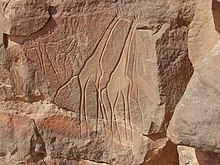
The domestication of cattle in Africa preceded agriculture and seems to have existed alongside hunter-gatherer cultures. It is speculated that by 6000 BC, cattle were domesticated in North Africa.[58] In the Sahara-Nile complex, people domesticated many animals, including the donkey and a small screw-horned goat which was common from Algeria to Nubia.
Between 10,000 and 9,000 BC, pottery was independently invented in the region of Mali in the savannah of West Africa.[59][60]
In the steppes and savannahs of the Sahara and Sahel in Northern West Africa, people possibly ancestral to modern Nilo-Saharan and Mandé cultures started to collect wild millet,[61] around 8000 to 6000 BCE. Later, gourds, watermelons, castor beans, and cotton were also collected.[62] Sorghum was first domesticated in Eastern Sudan around 4000 BC, in one of the earliest instances of agriculture in human history. Its cultivation would gradually spread across Africa, before spreading to India around 2000 BC.[63][64]

People around modern-day Mauritania started making pottery and built stone settlements (e.g., Tichitt, Oualata). Fishing, using bone-tipped harpoons, became a major activity in the numerous streams and lakes formed from the increased rains.[65] In West Africa, the wet phase ushered in an expanding rainforest and wooded savanna from Senegal to Cameroon. Between 9,000 and 5,000 BC, Niger–Congo speakers domesticated the oil palm and raffia palm. Black-eyed peas and voandzeia (African groundnuts), were domesticated, followed by okra and kola nuts. Since most of the plants grew in the forest, the Niger–Congo speakers invented polished stone axes for clearing forest.[66]
Around 4000 BC, the Saharan climate started to become drier at an exceedingly fast pace.[67] This climate change caused lakes and rivers to shrink significantly and caused increasing desertification. This, in turn, decreased the amount of land conducive to settlements and encouraged migrations of farming communities to the more tropical climate of West Africa.[67] During the first millennium BC, a reduction in wild grain populations related to changing climate conditions facilitated the expansion of farming communities and the rapid adoption of rice cultivation around the Niger River.[68][69]
By the first millennium BC, ironworking had been introduced in Northern Africa. Around that time it also became established in parts of sub-Saharan Africa, either through independent invention there or diffusion from the north[70][71] and vanished under unknown circumstances around 500 AD, having lasted approximately 2,000 years,[72] and by 500 BC, metalworking began to become commonplace in West Africa. Ironworking was fully established by roughly 500 BC in many areas of East and West Africa, although other regions did not begin ironworking until the early centuries CE. Copper objects from Egypt, North Africa, Nubia, and Ethiopia dating from around 500 BC have been excavated in West Africa, suggesting that Trans-Saharan trade networks had been established by this date.[67]
Early civilizations
Main article: Ancient Africa
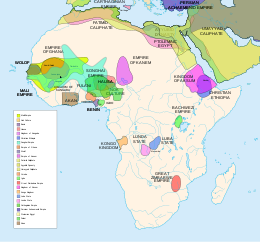
At about 3300 BC, the historical record opens in Northern Africa with the rise of literacy in the Pharaonic civilization of ancient Egypt.[73] One of the world’s earliest and longest-lasting civilizations, the Egyptian state continued, with varying levels of influence over other areas, until 343 BC.[74][75] Egyptian influence reached deep into modern-day Libya and Nubia, and, according to Martin Bernal, as far north as Crete.[76]
An independent centre of civilization with trading links to Phoenicia was established by Phoenicians from Tyre on the north-west African coast at Carthage.[77][78][79]
European exploration of Africa began with the ancient Greeks and Romans.[80][81] In 332 BC, Alexander the Great was welcomed as a liberator in Persian-occupied Egypt. He founded Alexandria in Egypt, which would become the prosperous capital of the Ptolemaic dynasty after his death.[82]
Following the conquest of North Africa’s Mediterranean coastline by the Roman Empire, the area was integrated economically and culturally into the Roman system. Roman settlement occurred in modern Tunisia and elsewhere along the coast. The first Roman emperor native to North Africa was Septimius Severus, born in Leptis Magna in present-day Libya – his mother was Italian Roman and his father was Punic.[83]
Christianity spread across these areas at an early date, from Judaea via Egypt and beyond the borders of the Roman world into Nubia;[84] by 340 AD at the latest, it had become the state religion of the Aksumite Empire. Syro-Greek missionaries, who arrived by way of the Red Sea, were responsible for this theological development.[85]
In the early 7th century, the newly formed Arabian Islamic Caliphate expanded into Egypt, and then into North Africa. In a short while, the local Berber elite had been integrated into Muslim Arab tribes. When the Umayyad capital Damascus fell in the 8th century, the Islamic centre of the Mediterranean shifted from Syria to Qayrawan in North Africa. Islamic North Africa had become diverse, and a hub for mystics, scholars, jurists, and philosophers. During the above-mentioned period, Islam spread to sub-Saharan Africa, mainly through trade routes and migration.[86]
In West Africa, Dhar Tichitt and Oualata in present-day Mauritania figure prominently among the early urban centers, dated to 2,000 BC. About 500 stone settlements litter the region in the former savannah of the Sahara. Its inhabitants fished and grew millet. It has been found by Augustin Holl that the Soninke of the Mandé peoples were likely responsible for constructing such settlements. Around 300 BCE, the region became more desiccated and the settlements began to decline, most likely relocating to Koumbi Saleh.[87] Architectural evidence and the comparison of pottery styles suggest that Dhar Tichitt was related to the subsequent Ghana Empire. Djenné-Djenno (in present-day Mali) was settled around 300 BC, and the town grew to house a sizable Iron Age population, as evidenced by crowded cemeteries. Living structures were made of sun-dried mud. By 250 BCE, Djenné-Djenno had become a large, thriving market town.[88][89]
Further south, in central Nigeria, around 1,500 BC, the Nok culture developed on the Jos Plateau. It was a highly centralized community. The Nok people produced lifelike representations in terracotta, including human heads and human figures, elephants, and other animals. By 500 BC, and possibly earlier, they were smelting iron. By 200 AD, the Nok culture had vanished.[71] and vanished under unknown circumstances around 500 AD, having lasted approximately 2,000 years. Based on stylistic similarities with the Nok terracottas, the bronze figurines of the Yoruba kingdom of Ife and those of the Bini kingdom of Benin are suggested to be continuations of the traditions of the earlier Nok culture.[90][72]
Ninth to eighteenth centuries
Main article: Medieval and early modern Africa
Pre-colonial Africa possessed perhaps as many as 10,000 different states and polities[92] characterized by many different sorts of political organization and rule. These included small family groups of hunter-gatherers such as the San people of southern Africa; larger, more structured groups such as the family clan groupings of the Bantu-speaking peoples of central, southern, and eastern Africa; heavily structured clan groups in the Horn of Africa; the large Sahelian kingdoms; and autonomous city-states and kingdoms such as those of the Akan; Edo, Yoruba, and Igbo people in West Africa; and the Swahili coastal trading towns of Southeast Africa.
By the ninth century AD, a string of dynastic states, including the earliest Hausa states, stretched across the sub-Saharan savannah from the western regions to central Sudan. The most powerful of these states were Ghana, Gao, and the Kanem-Bornu Empire. Ghana declined in the eleventh century, but was succeeded by the Mali Empire which consolidated much of western Sudan in the thirteenth century. Kanem accepted Islam in the eleventh century.
In the forested regions of the West African coast, independent kingdoms grew with little influence from the Muslim north. The Kingdom of Nri was established around the ninth century and was one of the first. It is also one of the oldest kingdoms in present-day Nigeria and was ruled by the Eze Nri. The Nri kingdom is famous for its elaborate bronzes, found at the town of Igbo-Ukwu. The bronzes have been dated from as far back as the ninth century.[93]
The Kingdom of Ife, historically the first of these Yoruba city-states or kingdoms, established government under a priestly oba (‘king’ or ‘ruler’ in the Yoruba language), called the Ooni of Ife. Ife was noted as a major religious and cultural centre in West Africa, and for its unique naturalistic tradition of bronze sculpture. The Ife model of government was adapted at the Oyo Empire, where its obas or kings, called the Alaafins of Oyo, once controlled a large number of other Yoruba and non-Yoruba city-states and kingdoms; the Fon Kingdom of Dahomey was one of the non-Yoruba domains under Oyo control.
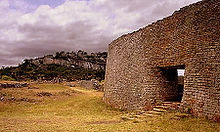
The Almoravids were a Berber dynasty from the Sahara that spread over a wide area of northwestern Africa and the Iberian peninsula during the eleventh century.[94] The Banu Hilal and Banu Ma’qil were a collection of Arab Bedouin tribes from the Arabian Peninsula who migrated westwards via Egypt between the eleventh and thirteenth centuries. Their migration resulted in the fusion of the Arabs and Berbers, where the locals were Arabized,[95] and Arab culture absorbed elements of the local culture, under the unifying framework of Islam.[96]
Following the breakup of Mali, a local leader named Sonni Ali (1464–1492) founded the Songhai Empire in the region of middle Niger and the western Sudan and took control of the trans-Saharan trade. Sonni Ali seized Timbuktu in 1468 and Jenne in 1473, building his regime on trade revenues and the cooperation of Muslim merchants. His successor Askia Mohammad I (1493–1528) made Islam the official religion, built mosques, and brought to Gao Muslim scholars, including al-Maghili (d.1504), the founder of an important tradition of Sudanic African Muslim scholarship.[97] By the eleventh century, some Hausa states – such as Kano, jigawa, Katsina, and Gobir – had developed into walled towns engaging in trade, servicing caravans, and the manufacture of goods. Until the fifteenth century, these small states were on the periphery of the major Sudanic empires of the era, paying tribute to Songhai to the west and Kanem-Borno to the east.
